- What is a Brand & Why is it Important?
- Elements of a Brand: Mission, Vision, and Values
- Types of Brands and their Significance
- Branding Strategies: Private, Multiproduct, and Mixed
- Brand Image and Its Impact on Perception
- Building a Strong Brand
- Frequently Asked Questions
- Understanding Brand Equity: Definition and Elements
- Importance of Brand Equity
- Evolution Of Brand Equity In The Digital Age
- Brand Equity in the Global Marketplace
- Measuring Brand Equity: Metrics & Methods
- Managing Brand Equity: Salient Elements
- Building & Managing Brand Equity: Best Practices
- The Future of Brand Equity
- Conclusion
- Frequently Asked Questions
- What is Brand Management?
- Importance of Brand Management
- Benefits of Effective Brand Management
- Principles of Brand Management
- Strategies for Successful Brand Management
- Brand Management vs. Marketing
- Conclusion: The Power of Brand Management
- Frequently Asked Questions
- Importance of Brand Image in Marketing
- Key Elements of a Successful Brand Image
- Brand Image vs. Brand Identity: Key Differences
- Measuring and Monitoring Brand Image
- Strategies for Maintaining and Enhancing Brand Image
- The Power of a Positive Brand Image
- FAQs
- What is Brand Awareness and its Importance?
- Benefits of Brand Awareness
- Brand Awareness Strategy: Some Tried & Tested Methods
- Some Creative Ways to Boost Brand Awareness
- Significance of Brand Awareness
- Conclusion
- Frequently Asked Questions
- Porter's 5 Forces Model: What Is It?
- Porter's 5 Forces Model: How To Use It?
- Common Barriers to Entry
- Evaluating Suppliers' Negotiating Power
- Understanding the Bargaining Power of Buyers
- Analyzing Threat of Substitute Products or Services
- Rivalry amongst Competitors (Old & New)
- Drawbacks of the Five Forces Model
- Conclusion
- Frequently Asked Questions
- How Well Do You Know Porter’s 5 Forces? Take A Quiz!
- What is Buying Motive?
- Types Of Buying Motives
- Importance Of Buying Motives
- Six Universal Buying Motives
- Identifying Buyer's Motives
- Utilizing Buying Motives In Sales
- Challenges In Interpreting Buying Motives
- Frequently Asked Questions (FAQs)
- 💸 Think You Know Buying Motives? Take A Quiz!
- Understanding the Elements and Importance of Brand Equity
- What are brand equity models?
- Comparing Keller's and Aaker's brand equity models
- Real-world examples of brand equity in action
- Strategies for building strong brand equity
- Key takeaways on brand equity models
- FAQs
- Mastered Brand Equity Models? Prove It!
- What Is Brand Positioning?
- The Importance of Brand Positioning for Businesses
- Creating A Brand Positioning Strategy: Step-By-Step Process
- Measuring the Success of Your Brand's Positioning
- Examples of Strong Brand Positioning in the Market
- Types of Brand Positioning Strategies
- Social Media Engagement: A Key Positioning Strategy
- What Makes a Good Brand Positioning Strategy?
- Conclusion
- Frequently Asked Questions
- Quick Quiz to Test Your Knowledge of Brand Positioning!
- Brand Personality: Definition & Importance
- How to Define Your Brand Personality?
- Choosing Your Brand Personality Attributes
- Dimensions of Brand Personality Framework: The Aaker Model
- Incorporating Core Values Into Your Brand Personality
- Examples of Brand Personalities in Action
- Conclusion
- Frequently Asked Questions
- Brand Personality Quiz– Let's Go!
- What is Brand Identity?
- What are the Key Components of Brand Identity?
- Importance & Benefits Of Brand Identity
- Importance of Unique Visual Elements in Brand Identity
- Communication Style and Tone of Voice in Brand Identity
- Steps on How to Create a Brand Identity
- Brand Identity Example- Coca-Cola
- Examples of Strong Brand Identities in Different Industries
- Consistency in Online and Offline Branding
- Conclusion
- Frequently Asked Questions (FAQs)
- Think You Know Brand Identity? Take A Quiz!
- Brand Identity Prism: Understanding The Concept
- Role Of Culture In Brand Identity Prism
- Brand Identity Prism: Visualizing The Sender & Receiver
- Benefits Of Brand Identity Prism
- Examples Of Brand Identity Prism In Action
- Brand Identity Prism: Key Takeaways
- Frequently Asked Questions
- Take This Brand Identity Prism Quiz!
- What is Market Segmentation?
- Importance of Market Segmentation
- The Market Segmentation Process
- Types of Market Segmentation
- Common Challenges in Implementing Market Segmentation
- Overcoming Challenges in Market Segmentation
- Conclusion: Understanding The Impact
- Frequently Asked Questions (FAQs)
- Test Your Market Segmentation Knowledge– Take This Quiz!
- What is Brand Loyalty? Meaning & Significance
- Characteristics of Brand Loyalty
- Measuring and Tracking Brand Loyalty
- Importance of Brand Loyalty for Companies
- Brand Loyalty Examples and Types
- Strategies for Building Brand Loyalty
- Differentiating Brand Loyalty from Customer Loyalty
- Conclusion: The Power and Importance of Brand Loyalty
- Frequently Asked Questions
- Think You Know Brand Loyalty? Take A Quiz!
- Brand Extension Meaning
- Brand Extension Types
- Understanding Brand Line Extension vs. Brand Extension
- The Impact and Potential of Brand Extension
- Successful and Unsuccessful Brand Extensions Examples
- Summing Up
- Frequently Asked Questions
- Quiz– Test Your Brand Extension!
- Step-by-step guide on how to build a brand from scratch
- Benefits of a Strong Brand
- Examining Successful Brand-Building Examples
- Summing up
- Frequently Asked Questions
- Know How to Build a Brand? Prove it With This Quiz!
- What is Marketing Mix?
- Understanding the 4 Ps of Marketing
- The Seven Ps of Marketing
- Implementing the Marketing Mix in Business
- Amul: Example of Successful Marketing Mix Implementation
- Exploring Alternative Marketing Mix Models
- Conclusion
- Frequently Asked Questions (FAQs)
- Mastered the Marketing Mix! Test Your Knowledge Now
- Defining Brand Value and its Importance
- Measuring Brand Value
- Factors that Make a Brand Valuable to Customers
- Examples of Brand Value from Real World
- Brand Value Versus Brand Equity
- The Impact of Brand Value on Business Marketing Strategies
- Conclusion: The Significance of Brand Value
- Frequently Asked Questions
- How Much Do You Know About Brand Value? Take This Quiz!
- Definition Of Co-Branding
- Different Types Of Co-Branding
- Benefits & Advantages Of Co-Branding
- Strategies For Successful Co-Branding Partnerships
- Notable Successful Co-Branding Examples
- Factors Influencing Co-Branding Success
- Frequently Asked Questions (FAQs)
- Co-Branding Quiz: Test Your Expertise!
- What is a Target Market?
- Importance of Target Market: Why Do We Need It?
- Types of Target Market
- The Target Marketing Process
- Primary Research for Target Markets
- Leveraging Target Market Segmentation for Sales
- Conclusion
- Frequently Asked Questions (FAQs)
- 🎯 Do You Know Your Target Market? Take the Quiz!
- Importance of Understanding Consumer Decisions
- Traditional vs Contemporary Consumer Behaviour Model
- Traditional Models of Consumer Behaviour
- Learning Model of Consumer Behaviour
- Psychoanalytical Model of Consumer Behaviour
- Sociological Model of Consumer Behaviour
- Economic Model of Consumer Behaviour
- Contemporary Models of Consumer Behaviour
- EKB Model of Consumer Behaviour
- Black Box Model of Consumer Behaviour (Stimulus-Response Consumer Behaviour Model)
- Howard Sheth Model of Consumer Behaviour
- Hawkins-Stern Model of Consumer Behavior
- Webster and Wind Model
- Nicosia Model of Consumer Behaviour
- How to Select a Consumer Behaviour Model?
- Final Remarks
- Frequently Asked Questions
- 🛍️ Consumer Behavior Models Quiz: Test Your Knowledge!
- What is a Consumer?: Definition & Role
- The Evolution of the Term "Consumer"
- Consumer Behavior
- Different Types of Consumers
- Consumers' Motivation for Buying
- Relationship Between Businesses and Consumers
- Consumer Rights in India
- Current Challenges for Consumers
- The Future of Consumers in a Digital Age
- Final Remarks
- Frequently Asked Questions (FAQs)
- 🛍️ Consumer or Customer? Test Your Knowledge!
- What is a Market Structure?
- Types of Market Structures
- How Markets Work
- Significance of Different Types of Market
- Summing Up
- Frequently Asked Questions
- 🏪 Market Structures 101: Take the Quiz!
- Understanding the Concept of Corporate Branding
- Importance and Advantages of Corporate Branding
- Researching Competitor Brands
- Implementing Effective Corporate Branding Strategies
- Successful Corporate Branding Examples: Alphabet, Walmart & SAP
- Impact and Success of Corporate Branding
- Conclusion
- Frequently Asked Questions
- 🏢 Corporate Branding Quiz: Test Your Knowledge!
- Perception Management: Meaning & Importance
- Process Of Perception Management
- Influencing & Shaping Perceptions
- Strategies For Perception Management
- Technology In Perception Management
- Branding & Control In Perception Management
- Customer Feedback For Perception Improvement
- Frequently Asked Questions (FAQs)
- 🧠 Perception Management Quiz: How Well Do You Know It?
- Definition & Importance Of Target Marketing
- Advantages & Disadvantages Of Target Marketing Strategies
- Examples Of Target Marketing Strategies
- Creating An Effective Target Market Strategy
- Segmentation: Key To Targeted Marketing
- Utilizing Social Media For Targeted Marketing
- Frequently Asked Questions ( FAQs)
- 🎯 Target Marketing Strategies Quiz: Test Your Knowledge!
- Definition and Significance of Brand Association
- Brand Association Types
- Successful Brand Association Examples
- Strategies for Building Strong Brand Associations
- Overcoming Negative Brand Associations
- Conclusion: Harnessing the Power of Brand Association
- Frequently Asked Questions
- 🔗 Brand Association Quiz: Check Your Brand Knowledge!
- What is Product Positioning?
- Importance Of Product Positioning in Marketing
- Difference between Product Positioning and Brand Positioning
- Types Of Product Positioning
- Main Components Of Product Positioning
- Successful Product Positioning Strategies
- Understanding the Product Positioning Process
- Examples Of Effective Product Positioning
- Conclusion
- Frequently Asked Questions (FAQs)
- 🔥 Product Positioning Quiz: Test Your Marketing Smarts!
- How do we define niche market?
- Strategies To Find Your Niche Market
- 7 Examples Of Niche Markets
- Benefits Of Targeting A Niche Market
- Testing Your Product Or Service For Niche Market
- Conclusion
- Niche Market: Frequently Asked Questions (FAQs)
- 🎯 Niche Market Quiz: Test Your Knowledge!
- Importance Of STP In Marketing
- Understanding STP in Marketing Step-by-Step
- Process Of Implementing STP In Marketing
- Examples Of Successful STP Strategies
- Conducting An STP Marketing Analysis
- Choosing Your Marketing Mix
- Strategies For Targeting the Right Audience
- Conclusion
- Frequently Asked Questions (FAQs)
- 🔍 STP in Marketing Quiz: Test Your Knowledge!
- Sales and Marketing: Understanding the Core Concepts
- Key Differences Between Sales and Marketing
- Types of Marketing
- Types of Sales
- Power of Synergy: Sales and Marketing Alignment (Smarketing)
- Frequently Asked Questions (FAQs)
- Definition Of Customer Satisfaction
- Importance Of Customer Satisfaction
- Strategies For Effective Customer Satisfaction
- Measuring Customer Satisfaction
- Customer Satisfaction in Marketing & Sales
- Frequently Asked Questions (FAQs)
- 🎯 Customer Satisfaction Quiz: Are You an Expert?
- Customer Delight Meaning
- Benefits of Customer Delight
- Customer Satisfaction Vs Customer Delight
- Strategies With Customer Delight Examples
- How to Measuring the Impact Of Customer Delight?
- Customer Delight Examples - 3 instances by big brands that won hearts
- Common Mistakes In Customer Delight
- Conclusion
- Frequently Asked Questions (FAQs)
- 🌟 Customer Delight Quiz: Can You Ace It?
- What is a Marketing Plan?
- Types Of Marketing Plan
- What are the Key Components of a Marketing Plan?
- Steps for Effective Marketing Planning
- Crafting Your SEO Content Strategy
- Budgeting & Resource Allocation
- Identifying & Analyzing Competition
- Measuring Success with KPIs
- Importance of Flexibility in Marketing Planning
- Challenges of Marketing Plan
- Marketing Plan vs Business Plan
- Conclusion
- Frequently Asked Questions (FAQs)
- 📊 Marketing Planning Quiz: Test Your Knowledge!
- What is Marketing Control?
- Types of Marketing Control (with Examples)
- Annual Plan Marketing Control
- Profitability Marketing Control
- Efficiency Marketing Control
- Strategic Marketing Control
- Process of Marketing Control
- Techniques Used in Marketing Control
- Frequently Asked Questions
Porter's 5 Forces: Comprehensive Guide To This Analytical Tool
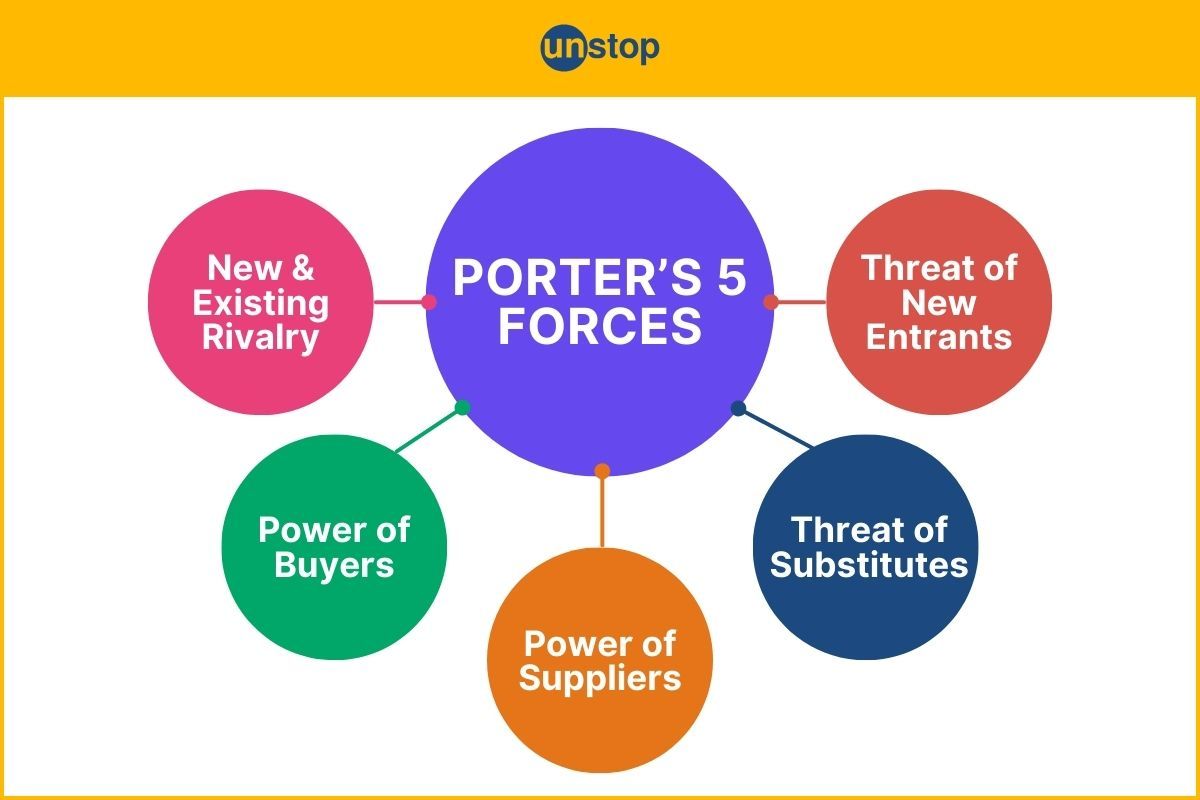
American businessman and Harvard Business School professor Michael Porter developed Porter's Five Forces framework in 1979. It is a renowned analytical tool for assessing industry attractiveness and shaping business strategy. This widely adopted model evaluates the competitive landscape by considering five key forces that impact profitability and influence a firm's position within its industry.
By comprehensively analyzing these forces, businesses gain valuable insights into the dynamics of their market environment.
Porter's 5 Forces Model: What Is It?
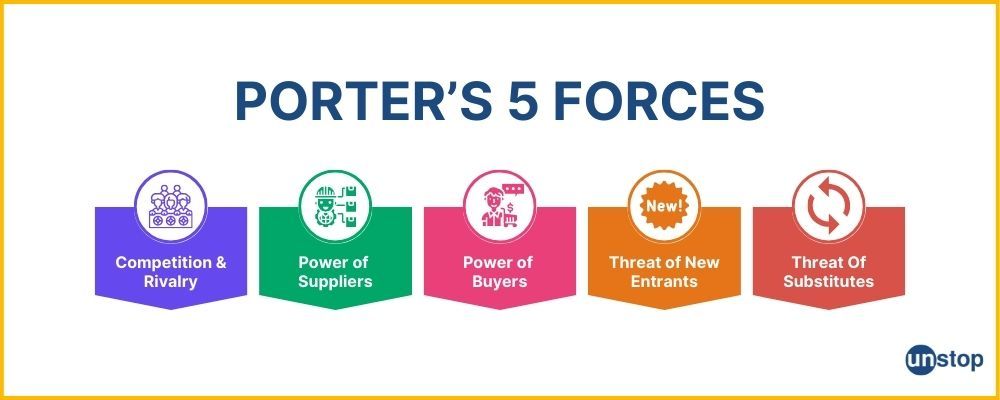
Porter’s 5 forces framework examines various factors or forces. Each force represents a distinct pressure that shapes competition within an industry. Through this structured analysis, firms can identify potential risks and opportunities, optimize their strategic decisions, and navigate dynamic market conditions effectively.
What are the five competitive forces?
- Threat of New Entrants:
- This refers to the potential for new competitors to enter the market. High barriers to entry can protect existing companies.
- Example: In the pharmaceutical industry, new entrants face significant challenges such as high research and development costs, and stringent regulatory approvals.
- Bargaining Power of Suppliers:
- This force assesses how much power suppliers can exert on the market. The fewer the suppliers, the more they can drive up costs.
- Example: In the smartphone industry, companies like Apple may face high bargaining power from unique component suppliers like those for OLED displays.
- Bargaining Power of Buyers:
- This determines how much pressure customers can place on businesses, affecting price, quality, and service. Higher buyer power occurs when buyers have many choices.
- Example: In the automotive industry, buyers have a wide range of choices, which increases their bargaining power, pushing for better deals.
- Threat of Substitute Products or Services:
- This force is about the availability of alternative products that can replace existing products. The easier and more affordable the substitute, the higher the threat.
- Example: The rise of video streaming services like Netflix has been a significant threat to traditional cable TV providers or even theaters.
- Rivalry Among Existing Competitors:
- This refers to the intensity of competition within an industry. High competition can lead to price wars, advertising battles, and new product launches.
- Example: The fast-food industry experiences intense rivalry among players, often leading to aggressive marketing and promotional strategies.
Porter's 5 Forces Model: How To Use It?
Identify Competitive Forces Shaping Industry Dynamics
The first step in using Porter's 5 Forces Model is to identify the competitive forces that shape the dynamics of your industry:
- Threat of New Entrants: Assess the barriers to entry for new competitors, such as economies of scale, brand loyalty, government regulations, and access to distribution channels. A high threat of new entrants can intensify competition within the industry.
- Bargaining Power of Suppliers: Evaluate the power suppliers have over your business by considering factors like supplier concentration, availability of substitute inputs, and switching costs. If suppliers hold significant power, they may be able to dictate terms or increase prices.
- Bargaining Power of Buyers: Analyze how much control buyers have over your products or services. Factors like buyer concentration, price sensitivity, and availability of alternatives influence buyer power. High buyer power could lead to price pressures or demands for increased value.
- Threat of Substitutes: Examine the likelihood that customers will switch to substitutes if your offerings become less attractive in terms of quality or price. Consider factors such as the cost of switching, product differentiation, and customer loyalty.
- Intensity of Competitive Rivalry: Evaluate the level of competition among existing players in your industry. Factors like market concentration, differentiation among competitors, and exit barriers affect rivalry intensity. High rivalry can lead to price wars and reduced profitability.
Assess Each Force's Strength and Impact on Profitability
Once you have identified these competitive forces, it is essential to assess their strength and impact on profitability. Consider the following:
- Determine the relative strength of each force by assigning a rating (e.g., low, medium, high) based on its influence within your industry.
- Analyze how each force affects your business's profitability. For example, a high threat of new entrants may lead to lower profit margins, while strong buyer power can exert downward pressure on prices.
By thoroughly examining each force and understanding its implications for profitability, you can prioritize areas that require strategic attention.
Support Strategic Decision-Making by Understanding Industry Attractiveness
Porter's 5 Forces Model ultimately aims to support strategic decision-making by providing insights into industry attractiveness. Armed with a comprehensive understanding of the competitive forces at play and their impact on profitability, businesses can make informed choices regarding market entry, pricing strategies, supplier relationships, and differentiation efforts.
Understanding industry attractiveness enables companies to:
- Identify opportunities for growth and expansion.
- Anticipate potential threats and develop contingency plans.
- Allocate resources effectively by focusing on areas with higher profit potential.
- Differentiate themselves from competitors in ways that are meaningful to customers.
Common Barriers to Entry
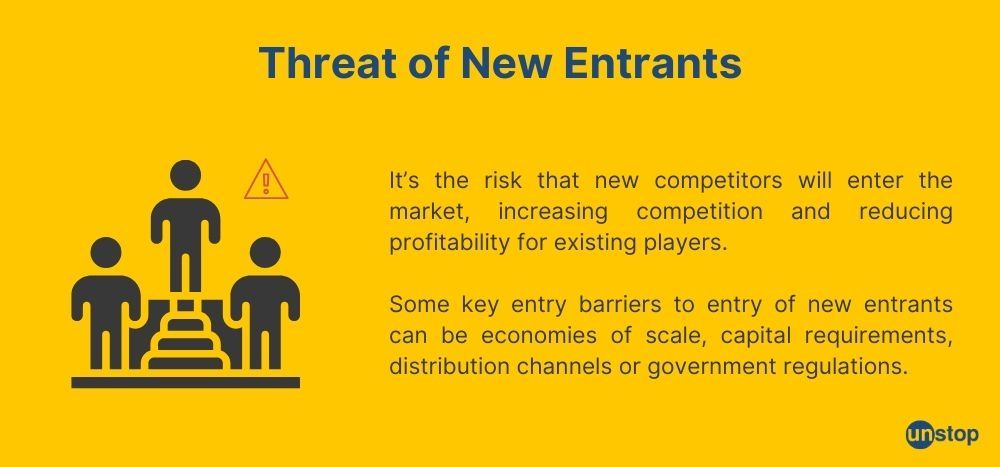
Entry barriers determine the ease or difficulty for new entrants to compete in a certain industry. Here are some key entry barriers that can deter new entrants:
- Economies of scale: Established companies often benefit from cost advantages due to their large-scale operations, making it challenging for newcomers to match their efficiency levels and pricing strategies. This advantage allows existing firms to maintain higher profit margins while potentially hindering market share growth for new players.
- Capital requirements: Certain industries, such as the airline industry, demand substantial investments in aircraft, infrastructure, and technology. The high capital intensity acts as a deterrent for those who lack sufficient financial resources or access to funding options. Consequently, established companies have the upper hand in terms of resources and are better positioned to withstand competitive pressures.
- Government regulations: Various sectors have stringent regulations imposed by authorities that aim to ensure safety standards, protect consumers' interests, or maintain fair competition. Compliance with these regulations requires time, effort, and financial investment. As a result, newcomers face hurdles in navigating these regulatory frameworks effectively.
- Distribution channels: Established companies often have well-established distribution networks, partnerships, and customer relationships, making it difficult for newcomers to gain traction in the market.
Higher entry barriers protect existing firms from new competition by reducing the threat posed by potential entrants. However, it is important to note that entry barriers alone do not guarantee sustained profitability or customer loyalty for established companies.
Innovative approaches, unique value propositions, disruptive technologies or changes in consumer behaviour can disrupt these dynamics and create opportunities even within industries with traditionally high entry barriers.
Evaluating Suppliers' Negotiating Power
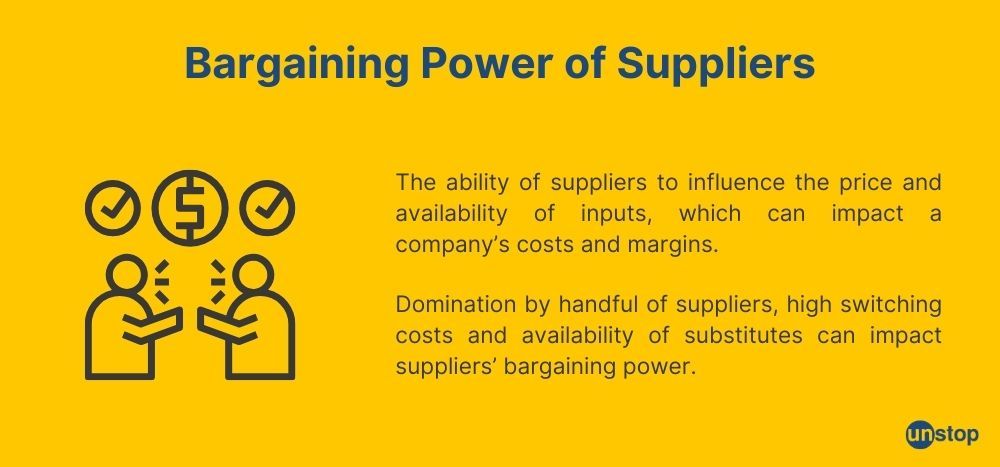
Suppliers provide the necessary resources and materials to keep operations running smoothly. However, their ability to dictate terms and prices can significantly impact a company's profitability and strategic decisions.
Factors Impacting Supplier Power
- Concentration: When a market is dominated by only a few major suppliers, their bargaining power tends to be higher. This concentration allows them to exert greater control over prices and terms. Conversely, in markets with numerous suppliers, each vying for business opportunities, their individual power diminishes.
- Availability of substitutes: The availability of alternative suppliers or substitute products can significantly weaken a supplier's position. If companies have multiple options for sourcing similar resources or materials, they can easily switch between suppliers without experiencing significant disruptions or increased costs.
- Switching costs: High costs of switching act as a barrier for businesses looking to change suppliers. These costs include expenses related to finding new sources, retooling production processes, or adapting to different quality standards. When switching becomes costly or time-consuming, suppliers gain leverage in negotiations.
Strategies to mitigate supplier power
While it may seem daunting to counteract strong supplier negotiating power, companies have several strategies at their disposal:
- Diversifying suppliers: By engaging multiple suppliers, businesses can reduce their dependence on a single source. This diversification not only mitigates the risk of disruptions but also increases competition among suppliers, giving companies more leverage during negotiations.
- Building long-term relationships: Cultivating strong relationships with suppliers can lead to mutually beneficial partnerships. Suppliers are more likely to provide favorable terms and prices when they value the business relationship.
- Investing in alternative resources: Exploring alternative resources or materials that are less dependent on specific suppliers can help reduce vulnerability to supplier power. Companies should continuously evaluate their supply chain and identify opportunities for substitution or innovation.
Understanding the Bargaining Power of Buyers
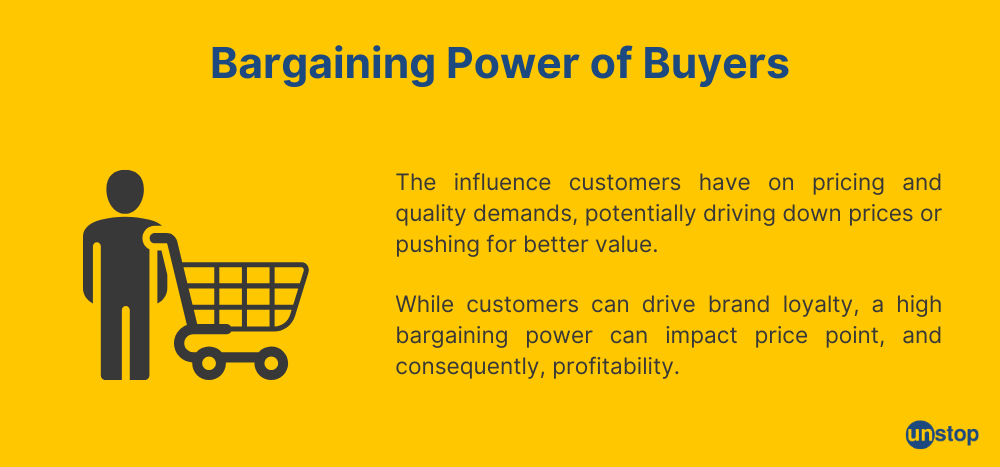
Buyers influence pricing and terms, significantly impacting a company's profitability and success. Understanding buyers' bargaining power is essential for businesses to navigate this dynamic relationship effectively.
Factors Affecting Buyer Power
- Concentration: The concentration of buyers within a market can greatly influence their bargaining power. When a small number of buyers dominate the market, they have more control over suppliers. In such cases, individual buyers may demand lower prices or better terms due to their significant purchasing volume.
- Price Sensitivity: Buyers' price sensitivity determines their willingness to pay for goods or services. If customers are highly sensitive to price changes, they may be more likely to switch brands or seek alternatives when faced with higher prices. This heightened sensitivity gives them greater leverage in negotiations with suppliers.
- Switching Costs: The costs associated with switching from one supplier to another also impact buyer power. High costs act as a deterrent for customers seeking alternative options, thereby strengthening their bargaining position. Conversely, low costs make it easier for buyers to switch suppliers and reduce their dependence on any single brand.
Implications of High Buyer Power
When buyers possess significant bargaining power, businesses must carefully consider the implications on profitability and pricing strategies.
- 1. Limited Profitability: High buyer power can limit a company's profitability by exerting pressure on profit margins through demands for lower prices or higher discounts. This situation becomes particularly challenging if there are multiple powerful buyers within an industry who can collectively drive down prices.
- 2. Control Over Prices: Buyers with substantial bargaining power may exert control over prices by dictating terms that favor them rather than the seller. This control can restrict a company's ability to set prices independently, reducing its flexibility in responding to market conditions.
Analyzing Threat of Substitute Products or Services
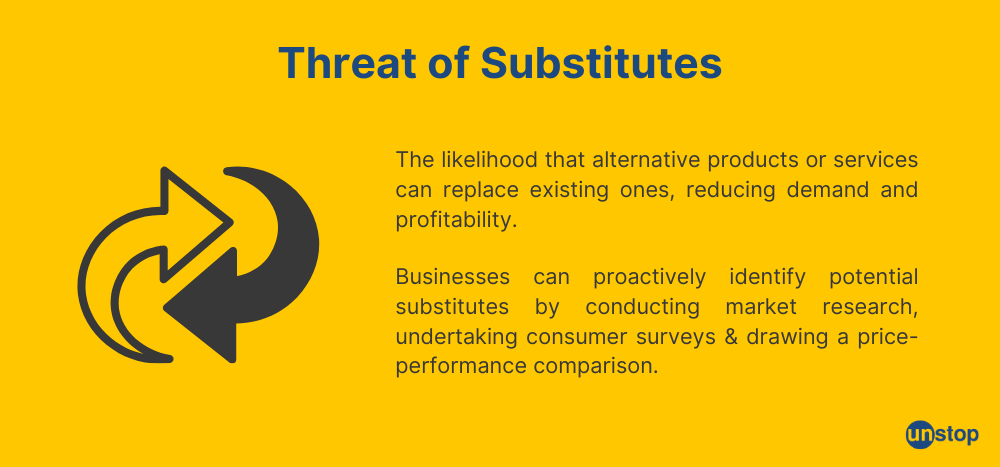
A high threat of substitutes can significantly reduce demand for existing products or services in an industry. Businesses need to be proactive in identifying potential substitutes and adapting accordingly to maintain their market share. Analyzing this threat allows companies to anticipate shifts in consumer preferences and take appropriate measures.
Factors Affecting Threat of Substitutes
- Price-performance ratio: Customers are always on the lookout for better value for their money. If a substitute product offers similar features and benefits at a lower price, it becomes an attractive alternative. For example, when smartphones were introduced, they quickly became substitutes for traditional mobile phones due to their enhanced functionality and competitive pricing.
- Switching costs: If customers face high switching costs when transitioning from one product or service to another, they are less likely to consider alternatives. Switching costs can include financial expenses, time investments, or even emotional attachments to a particular brand. For instance, some consumers may hesitate to switch from their favorite coffee shop because they have developed brand loyalty over time.
- Brand loyalty: Strong brand loyalty can make customers resistant to trying out new alternatives. Companies with established brands often enjoy a certain degree of protection against substitute products or services as customers associate their brand with quality and trustworthiness.
Analyzing the Threat of Substitutes
To perform an analysis of substitute products or services effectively, businesses can utilize various tools:
- Market research: Conducting thorough market research helps identify emerging substitute products early.
- Competitor analysis: Studying competitors' offerings provides insights into potential substitute products or services they may introduce.
- Customer surveys: Gathering feedback from customers can reveal their preferences and likelihood of switching to substitute products.
- Price-performance comparison: Comparing the features, benefits, and pricing of substitute products against existing ones helps assess the level of threat they pose.
Rivalry amongst Competitors (Old & New)
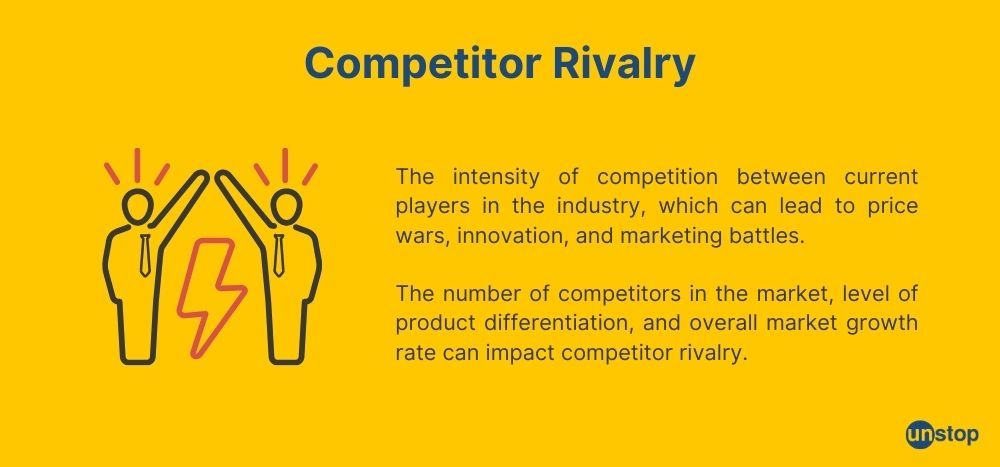
Companies constantly strive to gain a larger market share in the fiercely competitive business landscape, which increases rivalry and impacts industry profitability.
Factors Affecting Competitor Rivalry
- The number of competitors: When there are numerous players vying for the same customer base, it creates a highly competitive environment where each company tries to outperform others. This results in aggressive marketing strategies, price wars, and constant innovation as businesses seek to differentiate themselves from their rivals.
- The market growth rate: In rapidly growing industries, such as technology or e-commerce, companies may be more willing to engage in fierce competition as they anticipate a larger customer base and potential profits. Conversely, in mature industries with slower growth rates, competition might be less intense due to limited opportunities for expansion.
- Product differentiation: When companies offer similar products or services without any distinguishing features, customers often make purchasing decisions based solely on price or convenience. To stand out from the crowd and attract customers, businesses must invest in product innovation and create unique value propositions.
While competition among existing players can be fierce, entry barriers can deter new competitors from entering the market.
Drawbacks of the Five Forces Model
The main criticisms or drawbacks of Porter's Five Forces Model primarily revolve around its static nature and limited scope.
- First, the model is criticized for being too simplistic and not accounting for the complexity and dynamism of modern industries. It fails to capture the rapid changes in industries driven by technological advancements and globalization.
- Secondly, it overlooks other significant factors, such as government policies, social changes, and environmental concerns, which can also impact competitive advantage.
- Additionally, the model is heavily focused on external factors and does not consider a company's internal resources and capabilities, which can be crucial in developing sustainable competitive advantages.
- Lastly, it assumes a zero-sum game, implying that industries are closed systems where one entity's gain is another's loss, overlooking the potential for markets to expand and create win-win situations for companies.
Conclusion
In summary, Porter's 5 Forces Model stands as a timeless tool in the strategic analysis and business planning landscape.
By meticulously examining the competitive rivalry, the threat of new entrants, the bargaining power of suppliers, the bargaining power of buyers, and the threat of substitute products or services, businesses can gain a comprehensive understanding of their industry's competitive environment. This model not only helps in identifying the strengths and weaknesses inherent within a market but also aids in crafting strategies that leverage opportunities and mitigate threats.
Whether a business is considering entering a new market, assessing the viability of its current position, or looking for avenues to enhance its competitive edge, applying Porter’s 5 Forces Model can provide valuable insights that inform decision-making processes.
As the business world continues to evolve with technological advancements and changing consumer behaviors, this model remains relevant by offering a flexible framework that can adapt to various industry contexts. Therefore, embracing Porter’s 5 Forces Model is essential for any organization aiming to navigate the complexities of today’s competitive landscape effectively.
Frequently Asked Questions
1. What are some strategies to increase bargaining power with buyers?
Building strong relationships with customers through excellent service and product quality can enhance bargaining power with buyers. Offering unique value propositions or differentiating products can create a sense of exclusivity that strengthens negotiation positions.
2. How can companies mitigate the threat of substitute products or services?
Companies can mitigate the threat of substitutes by focusing on product differentiation and innovation. By continuously improving their offerings and addressing customer needs more effectively than substitutes, businesses can maintain a competitive advantage.
3. What steps can be taken to evaluate suppliers' negotiating power?
Evaluating suppliers' negotiating power involves assessing factors such as supplier concentration, availability of alternative sources, switching costs, and forward integration potential. Conducting thorough supplier audits and diversifying supply chains are effective strategies for mitigating risks associated with high supplier negotiating power.
4. How does rivalry among existing competitors affect industry dynamics?
Rivalry among existing competitors influences pricing strategies, marketing efforts, product development initiatives, and customer acquisition tactics. Understanding this dynamic allows businesses to anticipate competitive moves while identifying opportunities for differentiation.
5. What measures can businesses take to address the potential threat of new entrants?
To address the potential threat of new entrants, businesses can focus on building strong brand loyalty, establishing high entry barriers (e.g., patents, regulations), and continuously innovating to maintain a competitive edge.
6. How can businesses effectively utilize Porter's Five Forces model?
Businesses can effectively utilize Porter's Five Forces model by conducting comprehensive research and analysis for each force. This involves gathering industry data, evaluating market trends, and identifying key factors that influence competitiveness. The insights gained from this analysis can inform strategic decision-making processes and help businesses develop robust competitive strategies.
How Well Do You Know Porter’s 5 Forces? Take A Quiz!
You might also be interested in reading:
I’m a reader first and a writer second, constantly diving into the world of content. If I’m not writing or reading, I like watching movies and dreaming of a life by the beach.
Login to continue reading
And access exclusive content, personalized recommendations, and career-boosting opportunities.
Subscribe
to our newsletter












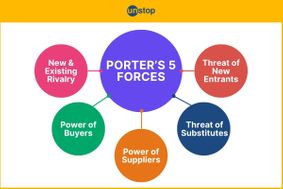



Comments
Add comment